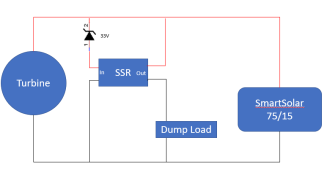Hi @FilterGuyLet's start with dump load. What is it and why it is needed?
On solar, when the batteries are full, the controller just shuts down the current flow and no further energy is produced.
On all turbines (water or wind), if the output is open corcuit, the generator produces no (or very little) resistance to spin. This means the turbine will spin much faster. This is called free-wheeling. This faster spin will, at a minimum, cause faster wear on the bearings. In the worst case, the turbine will spin so fast things start to break and it will destroy itself. Most wind turbines will destroy themselves in high wind if they are free-wheeling. Some water turbines can free-wheel without immediate damage, but it will always be hard on the bearings. (Bearings are often the first thing to go out on a turbine)
To prevent the damage of free-wheeling, the turbine should *always* be running under load. However, when the batteries are full, there is no place to put the energy so it gets routed to a 'dump load' to burn off as heat. Dump loads are usually banks of high wattage resistors. However, some people will do things like heat water with the excess load.
Unfortunately, the options for charge controllers that will enable a dump load are limited. The best controller for managing a dump load is probably the Midnite Solar 'Classic' series. If you really want to go first class, a Midnite Classic pared with a Midnight Clipper will give very fine-grain control over the dump load process. Schneider has the C30 and C60 controllers that can control a dump load.... but I am not a fan of those controllers. I am not aware of an ALL-in-one that has a PV input that would work well with a dump load.
Interestingly, the concept of MPPT has an analog with turbines. For a given pressure and flow (or wind speed) through the turbine, there is a voltage-current combination that will generate the most power. Consequently, a controller can adjust the current it allows through till it finds the correct voltage-current for the max power.
The Watter buddy has an integrated rectifier, so it outputs a rectified signal, but most wind and hydro turbines output a 3phase AC signal that must be put through a rectifier circuit before use in the rest of the system. These are 'simply' a set of bridge diodes that convert the AC to pulsed DC. (Warning, some of the rectifiers sold are only half-wave rectifiers... be sure to get a full-wave rectifier.)
Have you tried to do it with a Victron charge controller, using the included relay.
I found documentation from Power Spout that they have done it.
Wandering if anyone in the forum has had experience connecting the Victron to a hydro Turbine.
Victron Guide







